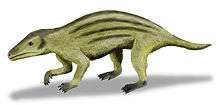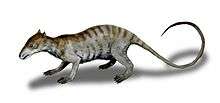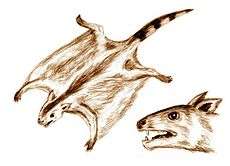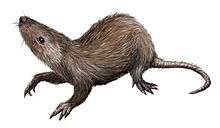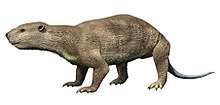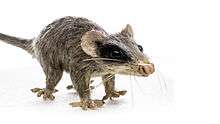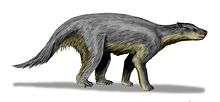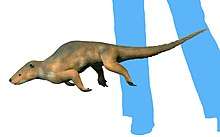Megalibgwilia
Megalibgwilia is a genus of echidna known only from Australian fossils that incorporates the oldest-known echidna species. The genus ranged from the Miocene until the late Pleistocene, becoming extinct about 50,000 years ago. Distribution of Megalibgwilia species were more widespread in warmer and moist climates. The extinction can be attributed to increasing acidification in Southern Australia.[1]
| Megalibgwilia Temporal range: Miocene – Late Pleistocene | |
|---|---|
 | |
| M. ramsayi humerus | |
| Scientific classification | |
| Kingdom: | Animalia |
| Phylum: | Chordata |
| Class: | Mammalia |
| Order: | Monotremata |
| Family: | Tachyglossidae |
| Genus: | †Megalibgwilia Griffiths, Wells and Barrie, 1991 |
| Species | |
Megalibgwilia was first described from a broken left humerus by Richard Owen when he identified "Echidna" ramsayi in 1884.[2] Complete skulls and postcranial fossils have since been described. A second species, M. robusta, was described in 1896 by Australian paleontologist William Sutherland Dun.
Although they are sometimes commonly referred to as giant echidnas, Megalibgwilia species are thought to have been similar in size to the contemporary western long-beaked echidna, but with slightly longer forearms.[3] They were smaller than a large species known from fossils in Australia, Zaglossus hacketti. M. ramsayi fossils have been found in deposits across mainland Australia and on Tasmania. M. robusta has only been found in New South Wales.[3] Megalibgwilia was probably an insect-eater, like the short-beaked echidna, rather than a worm-eater like members of Zaglossus.[4]
M. robusta is the oldest-known echidna and the only known Miocene species.[4]
References
- Ashwell, Ken W.S.; Hardman, Craig D.; Musser, Anne M. (October 2014). "Brain and behaviour of living and extinct echidnas". Zoology. 117 (5): 349–361. doi:10.1016/j.zool.2014.05.002. PMID 25053446.
- Owen, P. (1883). "Evidence of a Large Extinct Monotreme (Echidna Ramsayi, Ow.) from the Wellington Breccia Cave, New South Wales". Proceedings of the Royal Society of London. 36 (228–231): 273–275. doi:10.1098/rspl.1883.0073. JSTOR 109445.
- Long, J., Archer, M., Flannery, T. and Hand, S. 2002. Prehistoric Mammals of Australia and New Guinea: One Hundred Million Years of Evolution. Johns Hopkins University Press. pp 45–47. ISBN 0-8018-7223-5.
- Griffiths, M.; Wells, R.T.; Barrie, D.J. (1991). "Observations on the skulls of fossil and extant echidnas (Monotremata:Tachyglossidae)". Australian Mammalogy. 14: 87–101.
External links


- Extinct Animals : Megalibgwilia ramsayi - Reconstructions and skull images from Parks and Wildlife, South Australia

